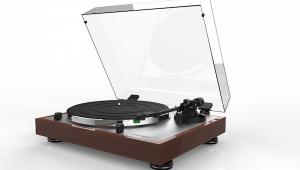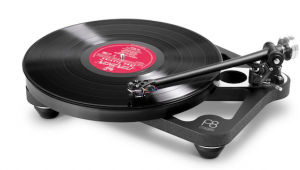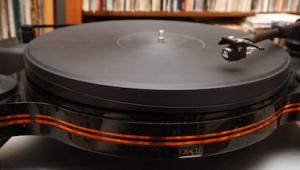Looking at the specs for the $3300 Prime 21- it shows coming with the JMW 9 Unipivot Arm and the smaller 10 pound platter. Looking at your photos- it appears you have the much heavier platter, a different gimballed arm, and the tonearm based with on the fly VTA. Is it possible you tested the PRIME SCOUT?
VPI Scout 21 Turntable

“Taking the design cues of the Prime Scout, the Scout 21 is an evolution of its predecessor with an improved 300rpm motor housing, and improved isolation feet. Paired with a JMW 9 tonearm!” Thus boasts VPI Industries’ official site regarding their Scout 21 turntable — the model that replaced the Prime Scout, a table that was reviewed by the late, great Art Dudley on our sister site Stereophile in September 2017.
In that review (which you can read in full here), Art wrote, “The new model sounds like a clearer, tightened-up, altogether more engaging version of the old. If you liked the Scout, you’ll really like the Prime Scout, which seems to offer good value, both comparatively and in and of itself."
Taking a cue from Art’s ever-wise thoughts, words, and deeds, the reasons I have for reviewing the VPI Scout 21 turntable today here on AP are twofold: 1) to gauge whether the Scout 21 is subjectively better than the Prime Scout table that Art had reviewed, and 2) to determine if the 21 shares a “house sound” with its much bigger and more expensive brother, the mighty VPI Avenger Direct ($36,000), which I reviewed for Stereophile in June 2023 — a table that, incidentally, continues to reside on a listening shelf in my home. (You can read that review here.) There are, of course, other VPI table contenders imminently forthcoming that will soon enough be officially announced that will ultimately get under our reviewing microscope, but we wanted to see and hear what’s what with the Scout 21 in the immediate here and now.

Features & Specs
The Scout 21 turntable ($3,300) stands 19 x 8½ x 15in (w/h/d) high and weighs 32lb. Its plinth is comprised of vinyl-wrapped MDF and steel, with a large, 11.5in wide aluminum platter that weighs 10.5lb. A strong 300rpm motor drives an exposed round rubber belt. The motor pulley appears to be aluminum. Wow & flutter is given as 0.08%, speed accuracy as 0.08%, and rumble as 78dB down.
The accompanying aluminum/steel VPI JMW 9in tonearm is a uni-pivot design, featuring VPI Copper weave internal wire. The tonearm has a low friction bearing mounted on a solid stainless-steel rod, and it employs an “adjustable drop counterweight” and azimuth side weights, along with vertical tracking angle (VTA) and vertical tracking force (VTF) adjustment capability.
Other specs of the Scout 21 include a pivot to spindle distance given as 223mm, effective length as 240.7mm, effective mass as 10.2g, overhang as 17.7mm, offset angle as 22.85º, and average RMS distortion as 0.36%.

Setup
Given the vagaries of turntable setup, the VPI Scout 21 was actually a cinch to assemble, like rocking a sailboat off the coast of NYC in beautiful weather. The various chunky bits — plinth, motor, belt, platter, and tonearm — fit together with a satisfying click. I’ve set up many turntables in my time, but none were easier to bring into being than the Scout 21. It just made sense, part after part.
The tonearm and base fit into two small but sturdy steel rods set into the plinth. The aluminum platter slid easily over the exposed well. The belt was a little tricky, as are most brand-spanking-new belts before becoming accustomed to rotating the platter. The heavy-duty motor was solid and grippy to the shelf surface. An aluminum counterweight slid over a plastic collar that circumferenced the tonearm’s end flank. Once secured, it was easy to adjust VTF via a butt-end dial. The turntable’s fat aluminum/rubber feet were also easily adjustable — something I can’t say for some more expensive tables, including the Avenger Direct.

Once I clamped the tonearm base into the two rods, I rolled the smooth-running VTA dial to bring the tonearm closer to the platter for a balanced tonearm-to-platter relationship. Azimuth was A-OK. A small nylon wire ran from the tonearm to the anti-skate post, which I set using Analogue Productions’ Ultimate Analogue Test LP (AAPT 1), which offers multiple setup parameters including an anti-skate track and a silent groove, neither of which require additional tools.
I mounted a VPI Shyla MC cartridge to the JMW 9 9in tonearm, ran a pair of Triode Wire Labs Spirit II interconnect cables (RCA) from the Scout 21’s output jacks into a Tavish Audio Design Adagio phono preamp on into a Riviera Levante integrated amp (via another pair of Triode Wire Labs ICs) driving Voxativ Ampeggio loudspeakers. Cables included interconnects from AudioQuest and Iconoclast speaker cables.
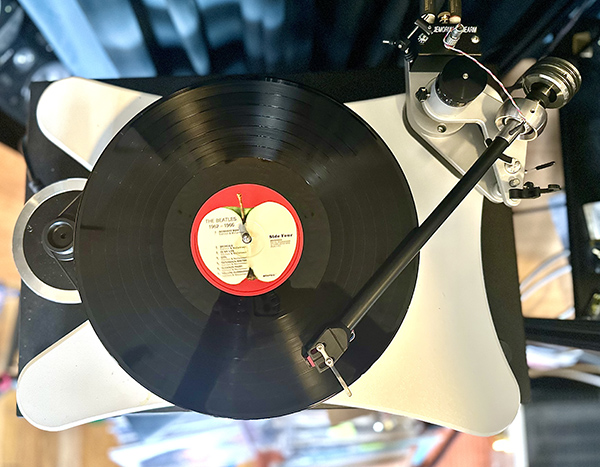
Listening Sessions
From the first LP dropped onto its platter, the VPI Scout 21 made its personality known. I began with my early-obtained copy of a forthcoming 2LP Blue Note release, McCoy Tyner and Joe Henderson’s Forces of Nature: Live at Slugs’ featuring Henry Grimes and Jack DeJohnette, as recorded at a long-lost NYC jazz haunt, Slug’s Saloon, in 1966. (Blue Note has Forces of Nature scheduled for release on November 22, 2024, for an SRP of $39.99, and it can be preordered here from Music Direct.)
I also listened to some of Jack’s solo and bandleader back catalog, most all of which I own. Those releases of his in my collection run a wide berth of jazz styles and production from the 1970s to the 1990s. With the Scout 21, I listened to 1969’s The De Johnette Complex (Milestone MSP 9022), 1971’s Have You Heard? (Milestone MSP 9029), 1975’s Cosmic Chicken (by Jack DeJohnette’s Directions; Prestige P 10094), 1980’s Special Edition (ECM Records 2301 152), 1983’s Inflation Blues (by Jack DeJohnette’s Special Edition; ECM Records ECM 1244), and 1998’s Audio-Visualscapes (by Jack DeJohnette’s Special Edition; Impulse! MCA2-8029). Jack’s jazz on these records ranges from psychedelic and spiritual to fire-breathing and heavily improvisational to near-new age cosmic music. I was dumbstruck at how well the Scout 21 table relayed the energy, drive, atmosphere, and power of these recordings, essentially all cut before the era of digital recording and click tracks.
Some of these DeJohnette LPs are primitive and brusque-sounding records, while others were seamless and pristine. The Scout 21 cast each record in its individual milieu, transparent to production aesthetics and studio environments. More importantly, the Scout 21 played the drums of DeJohnette — who is the greatest living jazz drummer, imo — with the requisite fire, power, drive, and dynamics contained in the records, some of which are 50-plus years old.

Though the Scout 21 didn’t deliver the last word in refinement, layering, or soundstage depth, it did excel as well as any turntable I’ve heard at delivering the swagger, swing, blood, and guts of real music played by real musicians in a recording studio. Sure, I could nitpick at its lack of low-end tightness — some acoustic bass could sound boomy, or it would evince a lack of “upper air,” as some call it. But the Scout 21 was too busy delivering the goods that matter — soul, swing, drive, and a sense of oomph — for me to care.
On a different tip, I recently picked up the 2023 remaster that is The Beatles’ 1962-1966 3LP set (Apple/UMG 0602455920539), which is serial-comma described on Discogs as being “3 x Vinyl, LP, Compilation, Limited Edition, Mixed, Reissue, Remastered, Stereo, Half-Speed Master, Red.” With remastering duties and lacquer cutting by engineer Miles Showell at Abbey Road, these LPs are currently the last word in Beatles stereo remasters. As one who owns all the original LPs and scores of European Beatles 45s, plus the recent remasters including the mono editions, I can say the 1962-1966 3LP set reveals even more detail while sacrificing nothing.
Through the VPI Scout 21/VPI Shyla combo, I marveled at the fresh-scrubbed sonic details, and perhaps better instrument placement, than the Giles Martin mixes. I’ve never heard Beatles tracks so cleanly remastered with excellent back-to-front layering, and with a level of exacting placement and imaging within the mixes that brought new revelations, track after track. The Scout 21 let The Beatles’ eternal good vibrations shine through, from the deep-toned guitar goodness of “Day Tripper” (LP2, Side Three, Track 4) and the glowing introspection of “In My Life” (LP2, Side Four, Track 2) to the bleary-eyed, seemingly lost-at-sea daydreaming of “I’m Only Sleeping” (LP3, Side Six, Track 3). The Scout 21 made it all dead-eye clear and wide-eyes resplendent.
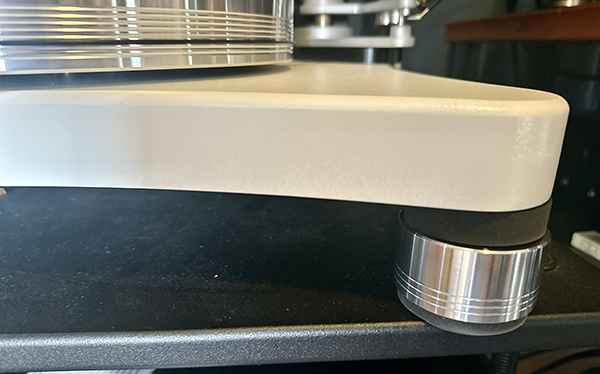
Conclusions
Compared to more expensive turntables from both VPI (i.e., the mighty Avenger Direct) and other manufacturers, the VPI Scout 21 lacked ultimate molecular/granular resolution, micro-speck pinpoint imaging, and uber-taut, synth-worthy bass. But this $3.3K table seriously swung and played it all warm and toasty, displaying a big heart. I would even say it displayed an inherent love of music, reflected in its wide rhythmic gait and warmhearted embrace of the LPs I spun on it. The 21 table is quite the fine fit in the VPI sound family, to be sure.
The Scout 21 turntable is not an analytical, surgical machine, but rather one focused on delivering the essence of the music in all its soul and swing, regardless of genre. In fact, I think this VPI table should be rechristened as follows, and henceforth be known as Scout 21: The Life Extender, Good Vibration Mender, Ultimate Heartbeat Turntable.
For more about VPI, go here.
To find an authorized VPI dealer, go here.
Author bio: Former musician, former artist, and former legal wastrel Ken Micallef has written numerous hi-fi equipment reviews for Stereophile and Analog Planet, and his byline has also appeared within Mojo, Electronic Musician, and The Grammys. You can also find him at YouTube (Ken Micallef Jazz Vinyl Audiophile).

- Log in or register to post comments


Performance not perforce!! Apologies for the typo...










